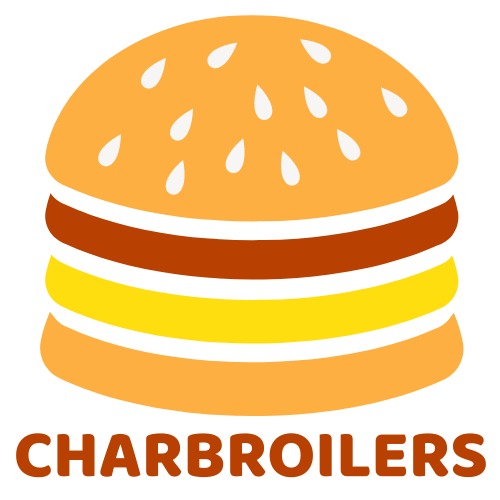
Grill Goals: The Best Charbroiler Restaurants to Try Now
Share
The Sizzle That Sells: Why Charbroiler Restaurants Dominate the Dining Scene
A charbroiler restaurant uses commercial charbroiling equipment as its primary cooking method to create distinctive sear marks, smoky flavors, and an irresistible sizzle. These establishments range from classic American steakhouses to gourmet burger joints and international grills.
What defines a charbroiler restaurant:
- Equipment: Commercial gas or electric charbroilers using radiant heat or infrared technology.
- Menu focus: Char-grilled steaks, burgers, seafood, and vegetables.
- Cooking method: High-heat cooking (550°F+) to trigger the Maillard reaction.
- Customer experience: Open kitchens showcasing flames and sizzling sounds.
- Cuisine types: American steakhouses, burger joints, Brazilian churrascarias, Mediterranean kebab houses.
The magic happens when food hits the superheated grates. As one industry expert noted, "Charbroiling exposes food to temperatures often in excess of 500°F," creating the perfect caramelization that makes dishes craveable. This is due to the Maillard reaction, a chemical process that creates complex flavors, while vaporized drippings infuse food with a smoky essence unique to this cooking method.
From historic spots like the Charco Broiler in Fort Collins to modern chains, these restaurants know the dramatic presentation and superior taste of charbroiled food create a premium experience.
I'm Sean Kearney from Charbroilers.com. With over a decade in the restaurant equipment industry, I've helped countless operators—from food trucks to high-volume steakhouses—choose the right charbroiler equipment to build successful concepts.
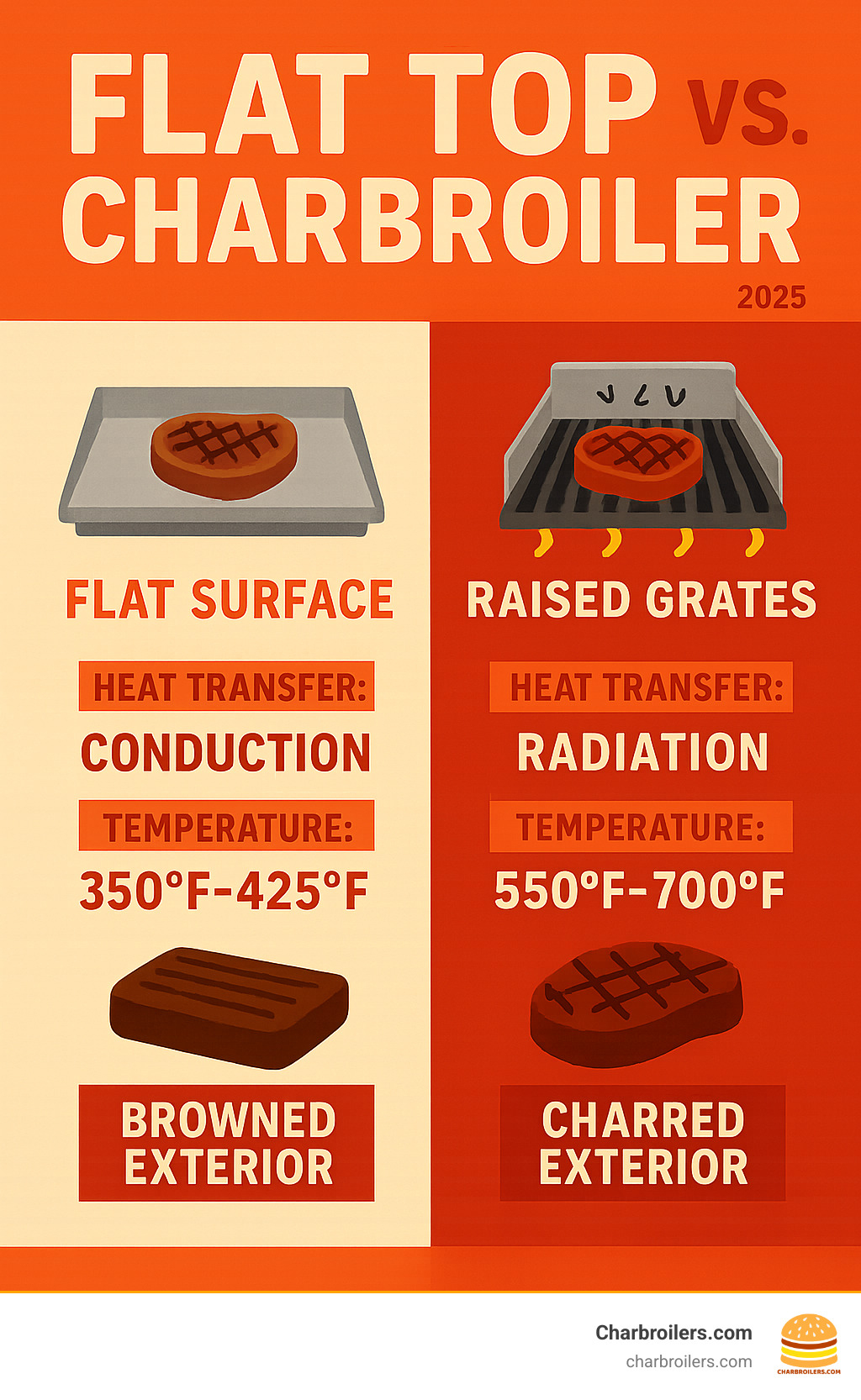
Basic charbroiler restaurant terms:
The Science of Sizzle: Why Charbroiling Creates Unforgettable Flavor
The sizzle, smoke, and flare-ups of a commercial charbroiler are theater, but the unforgettable flavor comes from food science. Charbroiler restaurants leverage this science to create unique dining experiences. Charbroiling isn't just heating; it's fundamentally changing food's molecular structure at temperatures of 550°F and higher, creating flavors that can't be replicated.
High-heat cooking on a charbroiler uses three heat transfer methods at once: conduction (hot grates), convection (hot air), and radiation (direct energy from the heat source). This triple-threat approach gives charbroiled food its distinctive characteristics.
The culinary advantages are clear. The smoky flavor profile develops when juices drip onto superheated surfaces below, vaporizing into aromatic clouds that infuse the food. This process, called "flavor redeposition," is unique to charbroiling. Then there are the distinctive sear marks—the beautiful crosshatch patterns that signal a caramelized crust, sealing in juices and adding textural contrast.
For restaurant operators wanting to dive deeper, resources like Food Quality and Consumer Value offer excellent insights, while The Ins And Outs Of Commercial Charbroilers provides practical equipment guidance.
The Maillard Reaction Explained
The Maillard reaction is the scientific name for what happens when amino acids and reducing sugars meet at temperatures above 300°F. It's far more complex than caramelization (which only involves sugars), creating the rich, savory, and roasted flavors we associate with perfectly cooked meat. The key is achieving browning, not burning. Proper Maillard browning creates depth, while burning creates bitter flavors. This flavor development is what separates a great charbroiler restaurant from the competition, creating a satisfying contrast between a crispy exterior and a juicy interior.
Achieving the Perfect "Char"
Creating the perfect char is where art meets science. Those branding marks are proof the Maillard reaction has created a flavorful crust. Key elements include:
- Smoke infusion: Happens when fats and juices vaporize on hot surfaces (radiants, lava rocks) and the resulting smoke flavors the food.
- Fat rendering: The extreme heat efficiently melts excess fat, crisping the edges and creating layers of texture and flavor.
- Controlling flare-ups: While some flame adds character, excessive flare-ups create soot. Experienced cooks manage hot spots by moving food or adjusting grate heights. Sometimes, chefs spray water on grills not just to prevent burning, but to cool sections and manage grease, as explained on Quora.
The perfect char balances beautiful grill marks, smoky flavor, and controlled heat, explaining why charbroiled food commands premium prices.
Blueprints for Success: Archetypes of the Modern Charbroiler Restaurant
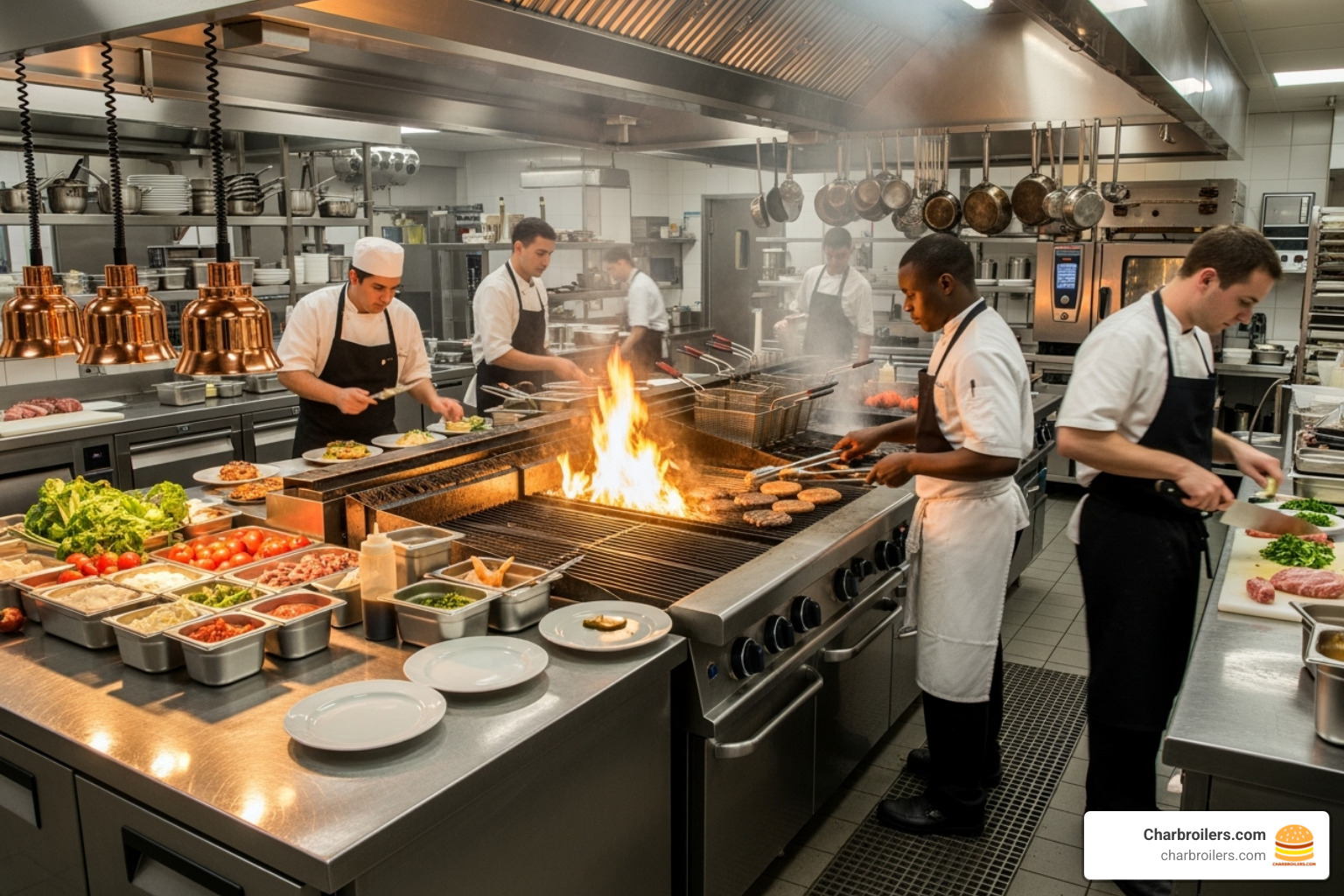
The sizzle, flames, and smoky aroma of a charbroiler are central to the customer experience. The equipment becomes the heart of the restaurant, creating an atmosphere diners crave. A charbroiler's versatility allows for unique concepts, from neighborhood burger spots to upscale steakhouses.
Let's explore three proven archetypes that have built successful businesses around the charbroiler. Each leverages the distinctive flavors and visual appeal that only charbroiling provides. For inspiration, see our guide to Raise The Steaks With These Commercial Broiler Champions.
The Classic American Steakhouse
This timeless charbroiler restaurant archetype uses the charbroiler as an altar for changing prime cuts of beef. The high heat creates a perfect caramelized crust on hand-cut steaks, locking in juices. Many steakhouses also apply this expertise to seafood offerings like salmon and swordfish. The high-end dining experience is improved by open kitchens that provide dinner theater, sophisticated ambiance, and classic wine pairings and side dishes. Establishments like Daniel's Broiler exemplify how focusing on expertly charbroiled proteins builds a lasting legacy.
The Gourmet Burger & Sandwich Joint
The fast-casual revolution proved that charbroiling lifts everyday comfort food. This charbroiler restaurant archetype starts with fresh ground beef patties, which develop a crispy, caramelized exterior and juicy interior on the grill—the signature of a true "charburger." Operators also use the charbroiler for toasted buns and charred vegetables, adding layers of flavor. The fast-casual model thrives on the high-volume capacity of charbroilers, and the open kitchen creates anticipation. This model is also popular for food trucks, as detailed in our Food Truck Cooking Equipment guide. Even iconic spots like The Wieners Circle use charbroiling to create a unique, smoky character.
The Global Grill: From Brazilian Steakhouse to Mediterranean Kebab
Charbroiling's versatility shines in international cuisine. A global charbroiler restaurant can transport diners with authentic, fire-cooked flavors.
- Brazilian churrascarias use charbroilers to slow-cook large cuts of meat on skewers, with servers carving tableside for an interactive experience.
- Mediterranean and Middle Eastern cuisines rely on charbroiling for authentic kebabs, where high heat caramelizes marinades and spices.
- Other examples include Korean BBQ (bulgogi, galbi) and Latin American dishes (carne asada).
Establishments like Astoria Shish Kebab House show how charbroiling bridges traditional recipes and modern operations. The versatility of charbroiling is key to delivering the authentic fire-and-smoke element that defines these cuisines.
The Engine Room: How to Choose the Perfect Commercial Charbroiler
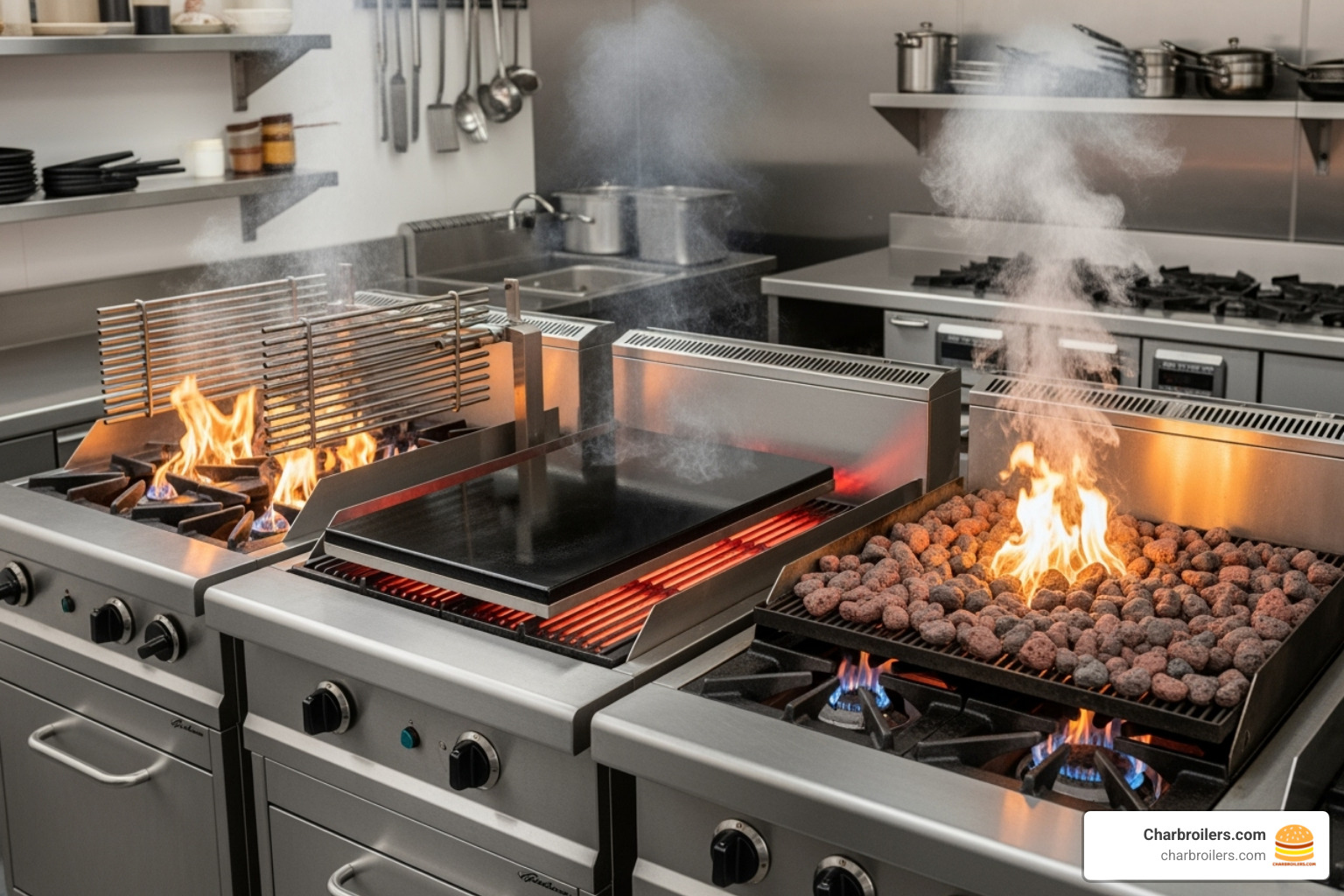
For a successful charbroiler restaurant, your equipment choice is critical. The right charbroiler can be a profit powerhouse, while the wrong one leads to frustration and lost revenue. Your choice should be guided by your menu, projected volume, and kitchen space. Today's market offers a charbroiler for every need, from small steakhouses to high-volume burger joints. For a complete breakdown, see our guide on the Best Commercial Charbroiler.
Fuel Source & Heat Transfer
Your fuel source shapes your restaurant's flavor profile, costs, and workflow.
Gas charbroilers are the workhorses of commercial kitchens, offering reliability, precise temperature control, and quick heat-up times. They use either radiant heat, lava rocks, or advanced infrared technology for high-volume searing. Gas units consume 15,000 to 30,000 BTU per burner per hour, with large models reaching up to 390,000 BTU/hr.
Electric charbroilers are ideal when gas is unavailable or restricted. They provide consistent heat and are easier to clean, but typically don't generate the same smoky flavor as gas or charcoal units.
Charcoal and wood fire grills deliver the most authentic smoky flavor but demand skilled operators and specialized ventilation with fire suppression. They require longer heat-up times and constant fire management.
Size, Grates, and Features
Choosing the right size and features is crucial for performance.
Size: Commercial charbroilers typically range from 24 to 72 inches wide. Countertop models save floor space, while freestanding units offer more cooking area and storage.
Power: BTU per burner indicates heating power. Higher BTU means faster recovery times during busy rushes.
-
Grates: Cast iron grates are the standard for their superior heat retention and ability to create perfect sear marks. They require seasoning but improve with age. Other features to look for include:
- Adjustable grates to control cooking temperature.
- Reversible grates with thick bars for searing and thin bars for delicate items.
- Specialized seafood grates with closer spacing.
Premium models feature closer burner spacing for more even heat distribution. For smaller kitchens, compact units can still deliver powerful results, as shown in our review of the Atosa 24 Charbroiler.
Mastering Operations: Efficiency and Safety in a Charbroiler Restaurant
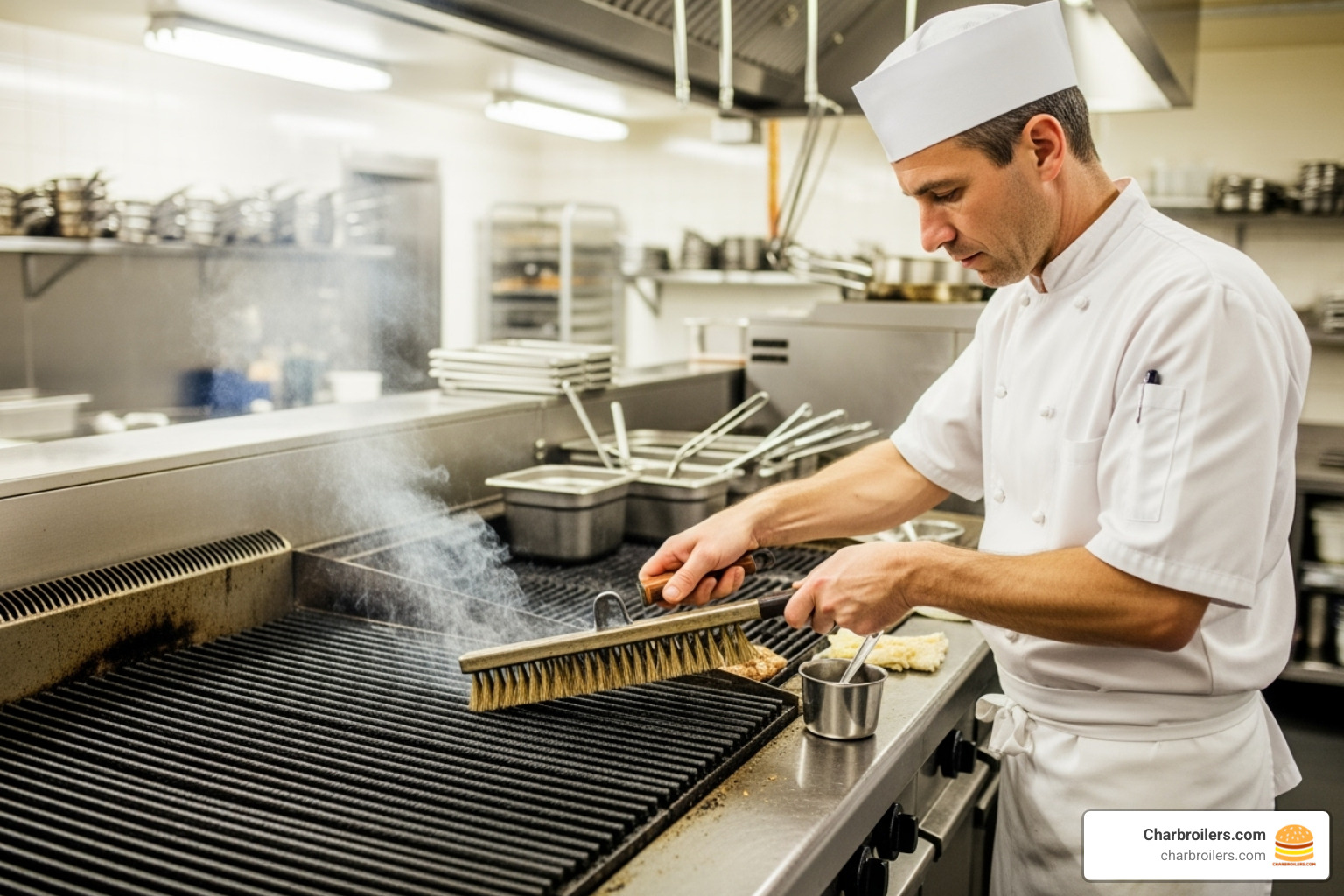
A successful charbroiler restaurant depends on mastering daily operations: managing energy costs, performing regular maintenance, and ensuring kitchen safety. The most profitable owners treat their charbroiler like the high-performance machine it is, focusing on the operational details that ensure consistency and longevity.
Managing Energy and Costs
Energy costs significantly impact charbroiler restaurant profits. A typical unit uses 15,000 to 30,000 BTU per burner, per hour, leading to daily energy costs of $6 to $40 for a single unit. To manage these costs:
- Use strategic preheating and avoid leaving the unit on full blast during slow periods.
- Practice zone management, using the charbroiler's natural hot and cold spots efficiently.
- Perform regular maintenance to ensure burners and radiants are clean and efficient.
- Provide employee training on proper temperature settings and workflow to minimize waste.
Essential Maintenance and Cleaning
Proper maintenance is crucial for food quality, safety, and equipment longevity. Key daily tasks include:
- Scrape grates with a wire brush to remove carbon buildup.
- Clean radiants or lava rocks to prevent grease accumulation and flare-ups.
- Empty and clean the grease tray to prevent fire hazards.
- Season cast iron grates with oil after cleaning to maintain a non-stick surface.
- Inspect burners for blockages that cause uneven heating.
- Keep the surrounding area free of grease and debris.
Ventilation and Fire Safety for your Charbroiler Restaurant
With intense heat and open flames, ventilation and fire safety are non-negotiable. Every charbroiler restaurant must have:
- Proper ventilation hoods and a makeup air system to handle smoke and heat.
- Clean grease filters to prevent them from becoming fire hazards.
- A UL 300-compliant fire suppression system to automatically extinguish fires.
- Adherence to NFPA standards (especially NFPA 96) for kitchen safety.
- Thorough staff training on safe operation, emergency protocols, and fire extinguisher use.
- Regular professional inspections of ventilation and fire suppression systems, as required by local codes.
Investing in proper systems and maintenance protects your staff, customers, and business. For more on kitchen systems, Energy-Efficient Ventilation offers valuable guidance.
Conclusion: Building Your Own Charbroiler Success Story
We've seen what makes a charbroiler restaurant so appealing: the science of the Maillard reaction and the smoky flavor from vaporized drippings. The right equipment is key, whether you're opening a classic steakhouse, a gourmet burger joint, or a global grill.
However, equipment is just the start. Operational excellence—managing energy costs (from $6 to $40 daily per unit), performing daily cleaning, and adhering to NFPA safety standards—is what ensures long-term success.
At Charbroilers.com, we've spent over four decades in the restaurant equipment industry. We are more than a supplier; we are your partner in bringing your culinary vision to life. Our Charbroilers.com solutions include an extensive selection of commercial kitchen equipment and flexible financing options custom to food service businesses.
The future of grilled cuisine is bright, as customer demand for authentic, char-grilled flavor remains strong. The sizzle, aroma, and perfect grill marks create an experience that keeps diners coming back.
Whether you're planning your first charbroiler restaurant or upgrading your kitchen, we invite you to explore our inventory. For more details, our Guide To Commercial Charbroilers For Your Restaurant has all the information you need.
Let's build your charbroiler success story together.
